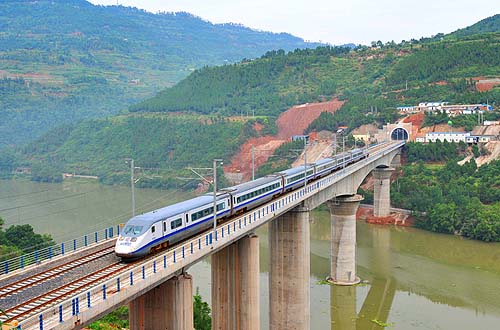|
 |
|
FAST CONNECTION: A passenger train connecting Sichuan Province's Dazhou and Chengdu cities passes a bridge on the newly renovated Dazhou-Chengdu Railway (CAO NING) |
The central and western regions of China are fast replacing the east coast as the new major driving force in the Chinese economy. It is a remarkable transformation during the economic recovery, signaling an improvement in balancing the development of the country.
Despite the sweeping effects of the global financial crisis, figures from the National Bureau of Statistics have shown 14 provinces reporting double-digit economic growth in the first half of this year. Most of this has occurred in central and western regions.
Notably, the Inner Mongolia Autono-mous Region ranked first in the nation with a staggering 16.2-percent year-on-year growth rate in the first half of this year.
Reasons
After China adopted its reform and opening-up policies in 1978, the economic growth rate in the eastern part firmly took the lead—in particular the economic miracles in Shenzhen and Guangzhou in Guangdong Province, Xiamen in Fujian Province, Shanghai, Tianjin and Dalian in Liaoning Province.
As the first group of costal cities opened to the outside world, these urban centers were also the first cities to accept foreign investment. Currently, the aggregated gross domestic product (GDP) of the eastern coastal regions accounts for more than 60 percent of the nation's total.
During the recovery that is following the financial crisis, however, the growth of coastal areas has fallen behind that of central and western regions.
Chen Xiushan, Director of the Institute of Regional and Urban Economics at Renmin University of China, says this is because most of the central and western regions are in the primary and mid-term process of industrialization and are, thus, mostly dependent on domestic demand and supply.
As a result, he noted, these regions were slightly affected by the global economic slowdown. Meanwhile, a considerable proportion of the government's 4-trillion-yuan ($586 billion) stimulus package was poured into infrastructure construction in central and western China, fueling an economic takeoff in those regions.
Another reason cited by Chen is that the government's previous measures to support central and western regions are now taking effect.
Since the mid-1990s, the Central Government has been pooling efforts to bridge the gap between regional development as part of an overall drive to bring common prosperity to all Chinese people. To this end, it has launched a series of campaigns, such as the "grand development of the western region" to support less developed areas.
Chen said these measures and policies have helped central and western regions develop exponentially. Moreover, the economic strength of those regions has been greatly enhanced. The GDP of the western region jumped to 5.8 trillion yuan ($849 billion) in 2008 from merely 1.4 trillion yuan ($205 billion) in 1998, showing an average annual growth of 11.42 percent, or one that is higher than the national average of 9.64 percent.
Li Xiaochao, spokesman for the National Bureau of Statistics, cited the economic structural reform as one of the biggest contributors to the rise of less developed regions, as greater amounts of capital have been invested in central and western regions to tap this inland potential.
In addition, Zhang Yansheng, Director of the International Economic Research Institute under the National Development and Reform Commission, said the rising consumer demand in those regions should also be attributed to their faster economic growth.
"Affected by the global financial crisis," said Zhang, "export-oriented eastern coastal regions are slower in picking up their growth momentum than the domestic market-driven central and western regions, which respond much more quickly than the former to the economic recovery."
Balanced development
Overall, faster development in central and western regions represents much desired progress for the government, which is in pursuit of balanced regional economic development.
But due to a number of reasons, Zhang said, the economic and social development in central and western regions still lags behind that of the more urbanized eastern coastal areas.
| 